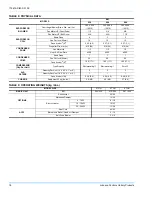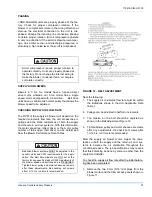
175619-XIM-C-0109
30
Johnson Controls Unitary Products
ECONOMIZER WITH SINGLE ENTHALPY SENSOR -
When the room thermostat calls for cooling, the low
voltage control circuit from “R” to “G” and “Y1” is com-
pleted. The UCB energizes the blower motor (if the fan
switch on the room thermostat is set in the “AUTO”
position) and drives the economizer dampers from fully
closed to their minimum position. If the enthalpy of the
outdoor air is below the setpoint of the enthalpy con-
troller (previously determined), “Y1” energizes the
economizer. The dampers will modulate to maintain a
constant supply air temperature as monitored by the
discharge air sensor. If the outdoor air enthalpy is
above the setpoint, “Y1” energizes the compressor and
condenser fan motor only.
Once the thermostat has been satisfied, it will de-ener-
gize “Y1”. If the compressor has satisfied its minimum
run time, the compressor and condenser fan are de-
energized. Otherwise, the unit operates the cooling
system until the minimum run times for the compressor
has been completed. After the compressor de-ener-
gizes, the blower is stopped following the elapse of the
fan off delay for cooling, and the economizer damper
goes to the closed position. If the unit is in continues
fan operation the economizer damper goes to the min.
position.
ECONOMIZER WITH DUAL ENTHALPY SENSORS -
The operation with the dual enthalpy sensors is identi-
cal to the single sensor except that a second enthalpy
sensor is mounted in the return air. This return air sen-
sor allows the economizer to choose between outdoor
air and return air, whichever has the lowest enthalpy
value, to provide maximum operating efficiency.
ECONOMIZER (SINGLE OR DUAL) WITH POWER
EXHAUST -
This system operates as specified above with one
addition. The power exhaust motor is energized 45
seconds after the actuator position exceeds the
exhaust fan setpoint on the economizer control. When
the power exhaust is operating, the second stage of
mechanical cooling will not operate. As always, the “R”
to “G” connection provides minimum position but does
not provide power exhaust operation.
MOTORIZED OUTDOOR AIR DAMPERS -
This system operation is the same as the units with no
outdoor air options with one exception. When the “R” to
“G” circuit is complete, the motorized damper drives
open to a position set by the thumbwheel on the
damper motor. When the “R” to “G” circuit is opened,
the damper spring returns fully closed.
COOLING OPERATION ERRORS
Each cooling system is monitored for operation outside
of the intended parameters. Errors are handled as
described below. All system errors override minimum
run times for compressors.
HIGH-PRESSURE LIMIT SWITCH
During cooling operation, if a high-pressure limit switch
opens, the UCB will de-energize the compressor, initi-
ate the ASCD (Anti-short cycle delay), and, stop the
condenser fan. If the call for cooling is still present at
the conclusion of the ASCD, the UCB will re-energize
the compressor.
Should a high-pressure switch open three times within
two hours of operation, the UCB will lock-out the com-
pressor and flash a code (see Table 8).
LOW-PRESSURE LIMIT SWITCH
The low-pressure limit switch is not monitored during
the initial 30 seconds of a cooling system's operation.
For the following 30 seconds, the UCB will monitor the
low-pressure switch to ensure it closes. If the low-pres-
sure switch fails to close after the 30-second monitor-
ing phase, the UCB will de-energize the compressor,
initiate the ASCD, and stop the condenser fan.
Once the low-pressure switch has been proven (closed
during the 30-second monitor period described above),
the UCB will monitor the low-pressure limit switch for
any openings. If the low-pressure switch opens for
greater than 5 seconds, the UCB will de-energize the
compressor, initiate the ASCD, and stop the condenser
fan.
If the call for cooling is still present at the conclusion of
the ASCD, the UCB will re-energize the compressor.
Should a low-pressure switch open three times within
one hour of operation, the UCB will lock-out the com-
pressor and flash a code (see Table 8).
FREEZESTAT
During cooling operation, if a freezestat opens, the
UCB will de-energize the compressor, initiate the
ASCD, and stop the condenser fan. If the call for cool-











































